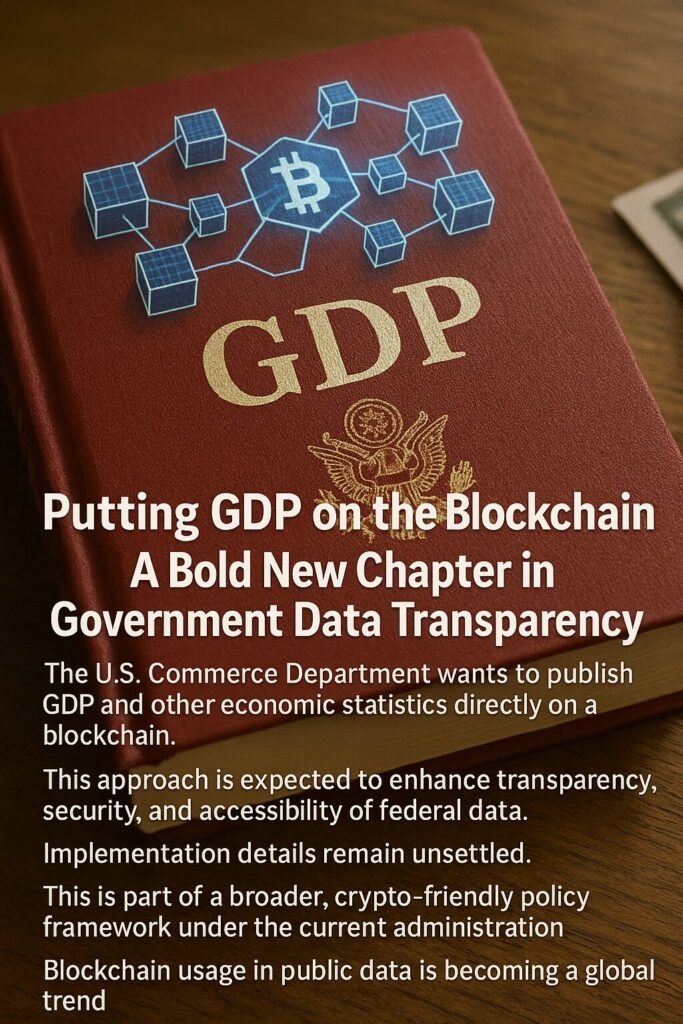
Main Points :
- The U.S. Commerce Department wants to publish GDP and other economic statistics directly on a blockchain.
- This approach is expected to enhance transparency, security, and accessibility of federal data.
- Implementation details remain unsettled.
- This is part of a broader, crypto‑friendly policy framework under the current administration.
- Blockchain usage in public data is becoming a global trend.
- Technologists, developers, and crypto‑curious innovators stand to benefit from the open distribution of immutable data.
Introduction
In a ground‑breaking policy announcement, U.S. Commerce Secretary Howard Lutnick revealed that the Commerce Department will begin issuing key economic statements—starting with Gross Domestic Product (GDP)—directly onto a blockchain. Framing the move as part of President Trump’s vision (his “crypto president” persona), Lutnick emphasized that this step will modernize how government data is distributed and consumed. While many practical specifics remain unconfirmed, the implications for transparency, innovation, and public trust could be transformative.
Blockchain-Published Economic Data: What and Why?
Lutnick confirmed during a White House cabinet meeting that the Commerce Department will “start issuing its statistics on the blockchain, because you are the crypto president.” He added: “We are going to put our GDP on the blockchain so people can use the blockchain for data distribution”.
By “on the blockchain,” the Department aims to embed public data like GDP within a tamper‑proof infrastructure. This should ensure that once released, economic data remains immutable and auditable—offering a verifiable chain of custody that builds credibility and makes manipulation far more difficult.
Enhancing Transparency and Public Trust
Government statistics wield immense influence on markets, policy, and public perception. Embedding GDP data in a blockchain could revolutionize how trust is engendered:
- Immutability ensures no alteration of historical figures, even by insiders.
- Auditability gives anyone—from researchers to journalists—the ability to independently confirm data integrity.
- Accessibility means open and direct access for front‑end tools, reducing dependence on official portals or PDFs.
Together, these promises align well with broader objectives of open governance and accountability.
Embracing Innovation—With Questions on the Path Forward
Lutnick stressed that the Department is “ironing out all of the details” regarding this rollout, leaving several elements unspecified:
- Which blockchain platform will be used—public (like Ethereum) or permissioned/private?
- What data release mechanisms will be employed? (Such as smart contracts or decentralized APIs?)
- Will data be released in real time or batched?
- What governance model will oversee data publication and amendments?
These unknowns leave room for speculation about scalability, security, and even unintended censorship or fragmentation.
A Node in the Crypto-Friendly Policy Web
This announcement builds upon a broader Trump administration initiative to support digital asset innovation, directed by a January 2025 executive order encouraging federal agencies to explore blockchain use cases. Moreover, the Commerce plan draws from historical efforts—like the aborted Elon Musk–backed “D.O.G.E.” department that attempted to publish government spending on‑chain—and ongoing pilots in other agencies such as the Treasury and CFTC.
Collectively, these efforts position the U.S. to transition from crypto oversight to crypto‑enabled governance—a strategic shift with long‑term implications.
Global Echoes: Blockchain and Government Transparency
The U.S. isn’t alone in applying blockchain to public data initiatives:
- Estonia has leveraged blockchain since 2016 to secure e‑health records, securing over a million patient profiles.
- The European Blockchain Services Infrastructure (EBSI)—launched in 2018—supports cross‑border digital public services across EU member states.
- Singapore and Australia have piloted blockchain for cross‑border trade documentation.
- California’s DMV employed permissioned ledgers to digitize vehicle titles and combat fraud.
These illustrations serve not only as templates but also as vivid proof that blockchain can shift from testing ground to live, production-grade infrastructure in government.
What This Means for Innovators and Crypto-Curious Audiences
If realized effectively, on‑chain GDP data could unleash new layers of innovation:
- Developers could write real‑time APIs, dashboards, or machine‑learning pipelines without relying on cached PDFs.
- Journalists and analysts might craft interactive tools that track economic trends with trustless verification.
- Entrepreneurs could launch subscription analytics products or investment research platforms anchored in immutable data.
- Policy tech supporters could adapt the U.S. model for local or state governments, or for enterprise contexts demanding audit‑ready transparency.
The synergy of public‑good data and crypto‑technical infrastructure could democratize economic insight like never before.
Final Thoughts
The U.S. Commerce Department’s decision to publish GDP data on the blockchain is emblematic of a shift from symbolic crypto posture toward operational blockchain governance. Though many questions remain—about implementation, utility, and governance framework—the move reflects growing recognition that technological transparency can be a pillar of public trust. If executed thoughtfully, this initiative may pave the way for a more open, resilient, and data‑first government, while offering fertile ground for crypto‑savvy innovators and accountability advocates alike.

